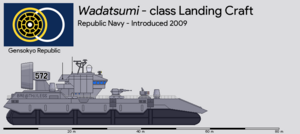Wadatsumi-class LCAC
 Side profile of Inaho Kaizuka-class landing craft.
| |
| Class overview | |
|---|---|
| Name: | Inaho Kaizuka-class LCAC |
| Builders: |
list error: <br /> list (help) Kawashiro Dynamics Acheron Technologies Naval Design Group Sasebo Naval Arsenal |
| Operators: |
list error: <br /> list (help) |
| In commission: | 7 July 1998 |
| Planned: | 224 |
| Completed: | 224 |
| Active: | 224 |
| General characteristics | |
| Class and type: | Inaho Kaizuka-class LCAC |
| Displacement: | 700 tonnes (full load) |
| Length: | 59.2 m (194 ft) |
| Beam: | 25.1 m (81 ft) |
| Draft: | 1.8 m (6 ft) |
| Propulsion: | 4 × Yatagarasu Turbo-engineering NT-200-120C turboshafts (12,000 kW (16,000 hp) each) (2 lift, 2 propulsion) |
| Speed: |
list error: <br /> list (help) 55 kn sustained 70 kn maximum |
| Range: | 550 km (340 mi) at 55 knots |
| Complement: | 4 officers and 24 enlisted |
| Sensors and processing systems: |
list error: <br /> list (help) ERS-548 surface search radar ERA-561 air search radar ERN-591 navigation radar |
| Electronic warfare & decoys: | 3 × AR/440 Softkill Decoy System |
| Armament: |
list error: <br /> list (help) 1 × "Aspis" CIWS 2 × 8-cell SML-751 Yukiho anti-air/anti-tank missile launcher 2 × CRA-334 15.5 mm revolver cannon Optional minelaying equipment |
| Armor: | 30 mm kevlar over engines |
The Inaho Kaizuka-class is a class of air-cushioned landing craft developed in the Gensokyo Republic and operated by the Republic Navy. Entering service in 1998, it is a large landing craft designed to ferry multiple tanks or infantry platoons ashore and provide covering fire for landings. Since its introduction into service, it has also been exported to the Punic Navy of Carthage as the Reykjavik-class and the Imperial Japanese Navy as the Type-097.
Design
With a range of 550 km (340 mi), the craft provides over-the-horizon assault capability, reducing the vulnerability of larger amphibious assault craft. The class is capable of transporting a platoon of tanks weighing up to 70 tonnes each or an infantry company ashore and deploying them on or beyond the beach with the ability to climb 1.5 m (5 ft) obstacles and 5 degree gradients. To protect itself and its passengers, the Inaho Kaizuka-class carries several softkill defense systems as well as a 35 mm Aspis CIWS and combined anti-tank/anti-air missile launchers. The class may also be fitted for minelaying duty if not carrying other cargo.
The Inaho Kaizuka-class is powered by four Yatagarasu Turbo-engineering NT-200-120C turboshafts, based on the core of the NT-200-85A model used in the QHU-50 Kittiwake heavy lift helicopter. Each provides 12,000 kW (16,000 hp) of power, with two dedicated to providing lift and the remaining two powering the propulsion rotors. At full speed the craft can reach speeds of up to 70 knots with a full load, although a speed of 55 knots is more common for improved fuel economy. Onboard fuel storage allows a range of up to 550 km (340 mi) at cruising speeds, although additional fuel tanks may be stored in the cargo bay at the expense of payload.
The hull is longitudinally divided into three main spaces, with the cargo bay in the center running the length of the ship, and crew and engineering spaces to either side. Crew and living space is sufficient to support independent operations for up to one week without troops embarked. The bridge is mounted in a tower above the hull for increased visibility and houses the radar and electronics. The craft is CBRN protected and equipped with air conditioning and heating for operation in all climates, and is capable of operating in conditions up to sea state 4.
Export
Shortly before entering service in 1999, the Punic Navy expressed interest in acquiring the class to supplement existing landing craft options, namely the smaller Inuk-built LCAC and conventional monohull craft. Purchasing a large LCAC like the Inaho Kaizuka-class would allow the Navy to land heavier forces more quickly, and with superior protection than existing landing craft. One unit was loaned to the Punic Navy in March 1999, and a contract for 144 landing craft was issued in May 2000. In Carthaginian service the class is known as the Reykjavik-class, after the Battle of Reykjavik in the Northern War, but individual units do not receive names. The first twelve Carthaginian landing craft were produced at the Kawashiro Dynamics yards but the remaining 132 were produced domestically at the Acheron Technologies Naval Design Group shipyards in Conakry. Final deliveries were completed in January 2014.
Similar trials were undertaken in Japan by the Imperial Navy, and the class was accepted alongside the larger Carthaginian-designed Panormus-class assault ship and Aokar Sephardis-class mobile landing platform, supporting the operations of the Special Naval Landing Forces throughout the empire. Sixty vessels were ordered under the designation Type-97 heavy landing craft. The first six vessels for the IJN were built at the Kawashiro Dynamics yards, but all remaining units were produced at the Sasebo Naval Arsenal.
Operators
 Gensokyo Republic
Gensokyo Republic
- Republic Navy - 40 delivered and in service
 Carthage
Carthage
- Punic Navy - 144 delivered and in active service
 Japan
Japan
- Imperial Navy - 40 delivered and in active service